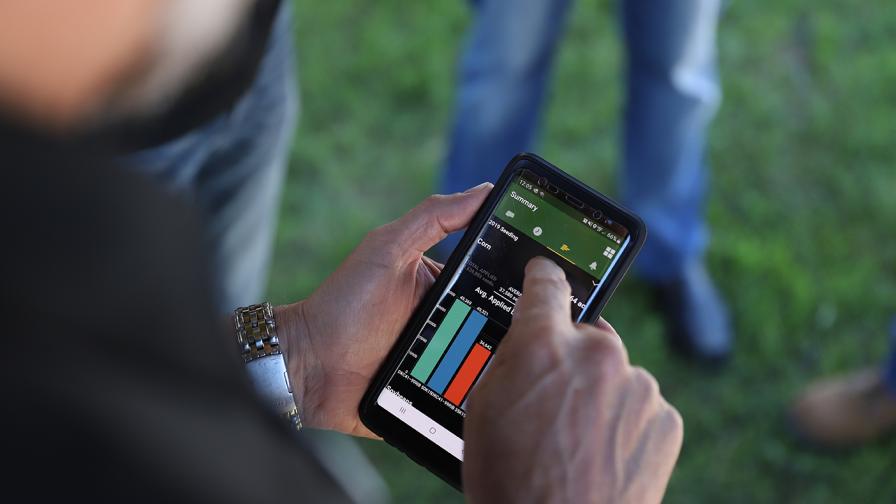Help Maximize Agronomic Data Value with a Six-Step Approach

Conducting a data health check can help save downtime and frustrations throughout the year, while ensuring primary focus remains on core tasks like planting, spraying, and harvesting.
Early in the year, most growers spend time in the shop getting equipment in prime condition for the upcoming season. As they check lubricants, inspect common wear parts, and give machines proper care, it is equally important to remind them that now is the time to do an annual data health check.
An annual data health check is an opportunity to review data, set goals, and ensure everyone on the team is ready for the growing season. The challenge is…well, there are plenty of challenges when it comes to working with growers and data. With more than a dozen growing seasons under my belt, I have seen firsthand that data can be a burden or a boon, depending on how well growers prepare for and actually use that data.
Challenges With Data
Depending on the farm and its size, the person in charge of data management might be a designated data expert or an operator who’s relatively data-savvy. On other farms, especially smaller owner/operator ones, I see that responsibility often falls to an individual that may be more pensive towards data and technology.
The level of knowledge among operators and other staff is also extremely varied from one farm to another. Some operators are overwhelmed by the display enough that they are constantly in field one, operations one, planting variety one, while others are more savvy. These are just a few of the challenges that make our role as trusted advisors equal parts tough and crucial.
Data challenges can be remedied by taking a step-by-step approach with growers, covering the following six areas that are key to building a good data management effort. Conducting this overall data health check can help save downtime and frustrations throughout the year, while ensuring primary focus remains on core tasks like planting, spraying, and harvesting.
1. Install Updates
Name a piece of technology that does not seem like it needs an update every 20 minutes. Okay, that is a slight exaggeration but the truth is updates are a part of modern life. They have to be done and there is no escaping them. I admit, I pushed the “delay update” button on my laptop at least 50 times in the past several weeks. But we all do that. No big deal, right?
Nothing is worse than a piece of technology deciding, at that pivotal moment it is needed, that it cannot go any longer without the update that was put off time and time again. With those systems at the heart of data collection, it is crucial to take care of all system updates during an annual data health check. It is also a good time to complete renewals, such as extending subscriptions and renewing software agreements.
I find it is helpful to explain this to growers in a way that mirrors a conversation about preventative maintenance. By planning for important maintenance tasks, the grower is in control of that downtime and can do it when it is most convenient. The same reasoning applies to technology updates. Plan that downtime with growers to take care of important updates and renewals, and there will be less chance of interruption during an inconvenient time, say, at 5 a.m. when harvest is in full swing.
2. Set Goals for Data
Goal setting is perhaps the most daunting task for growers when it comes to data but it is important to have clear expectations and purpose for the data. While we cannot set the goals for our grower partners, we can help them overcome two challenges related to the task and ensure their technology meets their goals.
First, growers may be unsure of what they want and need data to do. To help navigate this challenging technology step, I have a surprisingly non-technical strategy. It involves a simple piece of paper, then drawing a quadrant and designating each space for the key activities in the crop cycle: planting, spraying, and harvest. While those three will likely remain consistent across most farms, the fourth space varies based on the farm’s operation. It could be tillage, pruning, or other important task depending on the crop and location.
Next, have the grower answer the question: “In a perfect world, what would I want to measure in each of these areas?” Digging deeper, this question is about uncovering what data would mean the most to the operation’s decision management; what metrics would help make decisions faster, more accurately, and with fewer frustrations.
Even for growers who are more data-savvy and have been successful in setting and achieving goals in the past, this exercise is a great way to focus your grower’s data-gathering energy. Conversely, for growers who are newer to data or timid about using it, keep in mind that goals do not have to be life-changing; even small improvements in operation can be big wins.
One grower I worked with last year wanted to reduce idle time on his potato harvest trucks. He started by tracking how long his trucks sat idle at the field, waiting to be loaded during harvest, then how long they sat idle at the warehouse, waiting to empty. Having that baseline data, knowing how long they were currently idling, was the first step in his efforts to reduce the overall idle time.
The second common challenge growers face when setting data goals is they may be unaware of what their current equipment is capable of doing. At this point, you may want to bring in the grower’s precision agriculture dealer partner. I recently worked with a grower who had, what I’ll call, ‘data envy’ in that he saw a fellow farmer doing great things with his brand-new sprayer and all its data collecting capabilities. This grower was convinced that because he did not have a brand-new sprayer, he could not use data to improve his pesticide management in a meaningful way. Working in conjunction with one of our equipment experts, we showed him this was not the case. In defining his problems and discussing his goals, we found there was an aftermarket solution that could be added to his existing sprayer to do what he wanted it to do.
Once growers understand that data can do exactly what they want it to do or even that they’re able to collect and use data with existing equipment, they can set their S.M.A.R.T goals for each quadrant – specific, measurable, achievable, realistic, timely.
3. Review Past Data
After data goals are decided, the next step is to set up the machine’s system to collect and document data properly. Start by looking at the previous year’s data. For growers who tend to be negligent on reviewing data, it may be wise to go back a few years or even more.
For regular data users and goal setters, this is a chance to find data discrepancies, such as two combines in the field with discrepancies between their mass flow sensors, or other issues and solve them. If the system was not set up properly, that is an unfortunate error but simple fix. My colleague, Jacob Maurer wrote an article that covered “cleaning” bad data and is a great reference for explaining these management scenarios.
However, if a system error is not the issue, there are other areas to explore. It may be an issue with bad or inconsistent data entry (I will get to the solution for that shortly). Another factor that can make data appear inaccurate is a tough agronomic event. Drought, windstorms, temperature discrepancies are all significant events that disrupt normal operation and may cause data documentation to look incorrect. Noting this and being aware of agronomic events can help growers be less aggravated by data issues and return to their natural instincts.
This sleuthing step is an important one even for growers who do not set any data goals or plan to use their data at all. Just because there is not a plan to use the data now does not mean it might not come in handy in the future.
I recently visited a grower who had never used or even looked at the data being collected on his equipment. As he was preparing a report for his Farm Service Agency, related to his Conservation Reserve Program plan, he realized his machine seeding data could be helpful to create maps to prove his practices. Upon review, he realized the system was never set up and the machine had not collected anything on his seeding practices for three years. If he had pulled that data, even without using it, he would have known the discrepancies in year one instead of when he needed it.
The consolation is I was able to help him get set up to properly document going forward. Would it have been better for him to have the data right then in that time of need? Of course. But correcting this error was still a win. As the saying goes, “The best time to plant a tree was 30 years ago but the next best time is today.”
4. Set Clear Expectations With All Team Members
Farming is a team effort and getting everyone on the same page is critical to data success. A common practice for growers is to share goals and set expectations with staff in areas of equipment operation best practices, safety, and preventative maintenance schedules. It is equally important they do so for data management.
Often, growers or data managers push back on setting data gathering expectations or, in some cases, even using data at all because they do not want to overtax team members or expose them to unfamiliar concepts.
Both concerns are understandable. Operators are busy and not everyone is tech-savvy or skilled at data management. However, a well-crafted plan can be tailored to each grower and appropriate for all team members.
To help get buy in from team members, I have found that demonstrating how managers can make good decisions based on good quality data gives them a better sense of the “why” behind the initiative.
Once the “why” has been communicated, employees also need to understand their role and responsibility in data collection. Performance should be evaluated based, in part, on how well team members fulfill this role.
To make sure all understand their operational role, a hands-on approach is a great way to teach team members how to operate systems. Some equipment manufacturers offer online simulators but if that is not an option, growers can create one of their own by setting up a machine and bringing in team members to practice. The simple act of pushing buttons and getting more comfortable with the systems will help team members build good habits and incorporate them into their daily activities.
5. Set Data Standards and Enforce Them
With data, the old saying is, “garbage in, garbage out.” This just means that the data quality is key to good analysis. Therefore, I recommend working with growers to develop consistent standards for data. Remember in step #3, I suggested reviewing data to see if it was entered incorrectly? One of the biggest hiccups I see is when employees do not collect or enter data in the way that was anticipated or assumed. The latest software updates and technology allow the information from the farm manager to auto-populate the display. This is a great advancement for the data consistency issue and an opportunity to work with the grower’s dealership to build a program of automation.
An instance of data inconsistency I recently saw with a grower was because of a lack of an established naming convention. This grower’s system was set up for manual data entry, which many prefer for various reasons, yet leaves the user more vulnerable to error. There was no expectation set as to how fields were to be named so employees were renaming them as they entered data each day, in a way that made sense to them individually. Imagine how many different variations they came up with and how messy that made it on the backend. It was something simple that could have been prevented by establishing clear expectations up front.
Then, early in the season, the grower needs to regularly audit the data to make sure that the standards are being followed. Just a simple audit of the data entry can pay out big when it comes time to analyze the data.
6. Set Up Data Flow
The final box to check on a good data health check is the one that brings it all together. All the data in the world means nothing if there is no plan to review, analyze, and use it to make good decisions.
Think of reviewing financial data. Would you collect bank statements but never review them? Of course not; financial information is necessary to monitor budgets, and make immediate decisions and long-term plans. But unlike using farm data, the financial process is engrained, it is almost second-nature. Many growers are not yet adept to the data flow process, therefore it needs to be clearly spelled out.
As with planning downtime for updates, start the data flow plan with figuring out the most convenient time to review and analyze data. Depending on the goal, this could be a daily, weekly, or less-frequent activity. Next, schedule it regularly into the growing season in the same way that financial, maintenance, or training activities are scheduled.
This step, as well as the entire reasoning to do a data health check really boils down to the idea of ensuring data is infused into a grower’s agricultural life as any other necessary piece of the business.
Data is not a small task. It can be a cultural change for many operations. Helping growers prioritize it and see it as an important part of the business is as valuable as any of these steps.
Visit www.RDOequipment.com to learn more about precision agriculture and data management.






